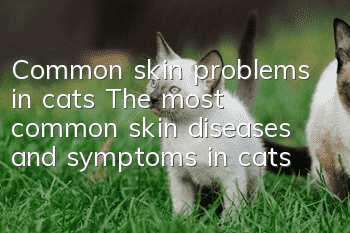Common skin problems in cats The most common skin diseases and symptoms in cats

Common types of skin diseases include: bacterial skin diseases, fungal skin diseases, ringworm, seborrheic skin diseases, ectoparasitic skin diseases, mite infections, allergic skin diseases, metabolic skin diseases , immune abnormality skin disease.
Common types of skin diseases
Bacterial skin disease: mainly caused by bacterial infection. Pyoderma and folliculitis are common bacterial infections.
Fungal skin disease: caused by fungal infection of the skin; skin fungi survive for a long time in nature, have strong resistance, and can survive for more than 1 year in a dry environment. There are also some fungi that have an affinity for soil and can grow and reproduce in the soil and survive for a long time.
The most common cat ringworm, ringworm, is classified as a fungal infection. Typical symptoms are local hair loss, papules, mixed spots and scarring. Cat ringworm is highly contagious and is common to humans and animals. Once discovered, it must be treated and controlled as soon as possible.
Seborrheic dermatosis: Abnormal oil secretion, typical symptoms of black tail and chin.
Ectoparasitic skin diseases: caused by fleas, scabies, demodex, ear mites, lice, ticks, etc. The itching sensation of the bites causes the cat to scratch, which can easily lead to secondary infection.
Mite infection, or mixed infection with mites and fungi, is a type of skin disease that is highly common and difficult to treat, so if your cat has symptoms of mites, don’t hesitate and seek medical advice as soon as possible.
Atopic dermatoses: Allergies caused by parasites, food and other allergens.
Metabolic dermatoses: hormonal dermatoses;
Immune abnormality skin diseases: nutrition-related skin diseases, etc.
Methods to prevent and treat cat skin diseases
1. Diagnose the cause
Only by going to the hospital as early as possible to diagnose the cause of the disease can targeted treatment be most effective without delaying the condition.
2. Control infection
Especially for skin diseases such as cat ringworm, which are highly frequent and easy to relapse, topical or regular medicinal baths to resist infection are very helpful
3. Fur care
You need to pay attention to your cat's skin health, comb your cat's hair regularly, and bathe it with natural and mild bath waves.
4. Supplement nutrition
If the cat’s hair is of poor quality, prone to hair loss, dry and dull, you can supplement the fur nutrition regularly.Improves coat health.
5. Clean environment
The living environment of cats must be kept clean, and bedding and other items must be disinfected when cat ringworm occurs!
- A cat will die if it urinates for a few days
- Should you deworm yourself or go to a pet store?
- Are cat teasers harmful to cats?
- What should I do if my cat suffers from chronic gingivitis?
- Cat's nails are cracked with a thin layer
- Cats go crazy after eating mutton
- What does cat moss on a cat’s chin look like?
- Can cats reproduce after abdominal transmission is cured?
- What exactly is the sterilization shot for female cats?
- Can I still eat unopened cat food if it has expired?



